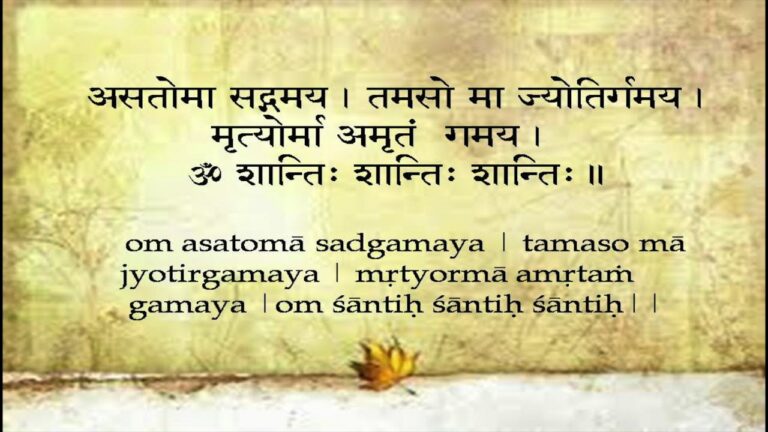
ॐ असतो मा सद्गमय ।
तमसो मा ज्योतिर्गमय ।
मृत्योर्मा अमृतं गमय ।
ॐ शान्तिः शान्तिः शान्तिः ॥
oṃ asato mā sadgamaya |
tamaso mā jyotirgamaya |
mṛtyormā amṛtaṃ gamaya |
oṃ śāntiḥ śāntiḥ śāntiḥ ||
Brihadaranyaka Upanishad, 1.3.28
Rishi-Devata-Chandas:
This Shanti Mantra from the Brihadaranyaka Upanishad is a set of three profound Mantras. The Rishi and Chandas of the Mantra is not known. But the divinity addressed by this Mantra is the Paramatman – the supreme consciousness.
असतः asataḥ – from unreality;
मा mā – me;
सद् sad – (to) reality;
गमय gamaya – lead;
तमसः tamasaḥ – from darkness;
मा mā – me;
ज्योतिः jyotiḥ – (to) light;
गमय gamaya – lead;
मृत्योः mṛtyoḥ – from death;
मा mā – me;
अमृतं amṛtaṃ– (to) immortality;
गमय gamaya – lead.
Lead me from unreality to reality. Lead me from darkness to light. Lead me from death to immortality.
Asato ma Sat gamaya - Asat points to superficial (Vyavaharika) level of understanding things and performance of action (svabhavika-karma- vijñāna). Sat refers to well-refined knowledge and action known from the scriptures (Śastriya-karma- vijñāna). The prayer to the supreme Brahman is to lead us from unrefined state of knowledge and action to refined knowledge and refined way of performing actions.
Tamaso ma Jyotir gamaya - Tamas points to ignorance and wrong knowledge, ajnana. Jyoti refers to correct/authenticknowledge, jñāna. The prayer here is to lead us from ignorance to knowledge.
Mrityor ma Amritam gamaya - From death lead me to immortality. In this context, Acharya Shankara states that as the previous two are (relatively) obscure concepts (Asat and Sat, Tamas and jyoti) they needed explanation. The desire/prayer for journey from death to immortality is very well known, and hence special explanation is not given. Meaning, at the core, every human being has this yearning and urge to reach immortality and hence it is not obscure but very evident. This clarifies the natural, ultimate destination of human journey.
Further, a gradual progression could be observed here - only when our understanding of the world and performance of actions are guided by our Śāstras [means "precept, rules, manual, compendium, book or treatise" in a general sense] (Mantra 1) - we can shake off the veil of ignorance in the form of distractions, afflictions and agitations, and move towards knowledge about the reality in focused and peaceful manner (Mantra 2). After that, when we are able to assimilate the knowledge and convert it into realisation by our Tapas (single pointed focus) - that is when we transcend death and attain immortality (get established in Sat-Cit-Ānanda).
An important observation is made regarding the Viniyoga (application) of the Mantra by Acharya Shankara. He states that, in the context of the Brihadaranyaka Upanishad, the above three Mantras are for japa for the one who has the clear understanding of the functioning of the prāṇa (prāṇa - vijñāna).
Two points can be noted from the comment –
Source: https://www.academia.edu/95958110/Vedic_Mantra_artha_Asato_Ma_Sad_gamaya